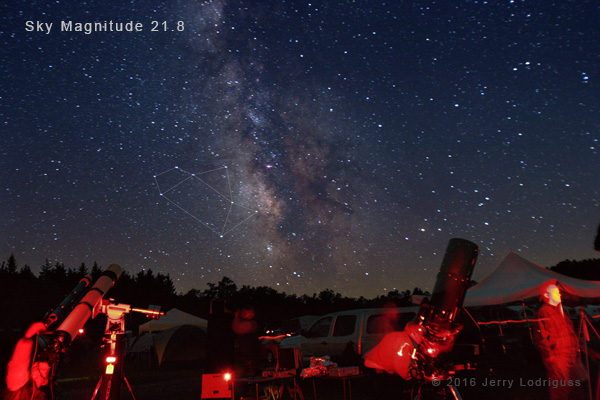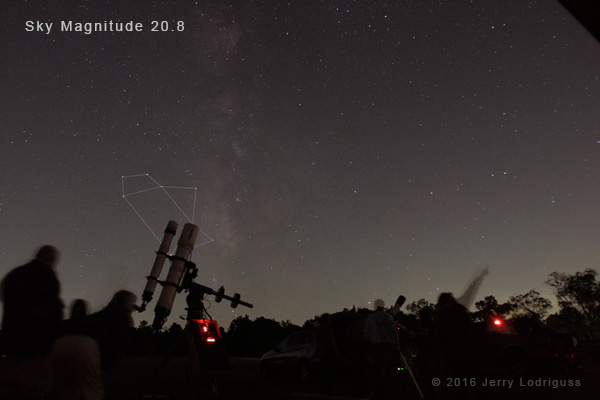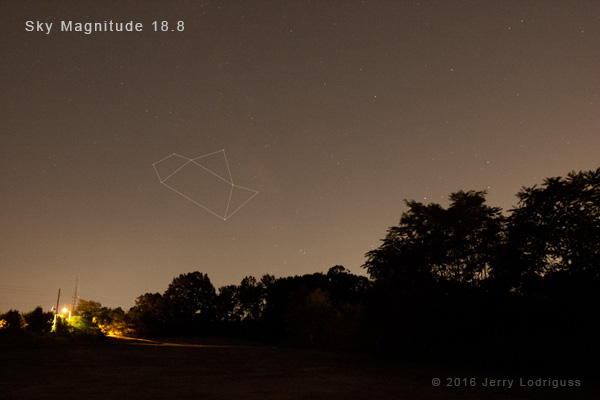Astronomy - Astrophotography: The Benefits of Dark Skies
Can you photograph galaxies and star clusters from your backyard? That depends - how light-polluted is your yard, and how much time do you have?

Imaging at a true dark-sky observing site allows fainter objects to be more easily seen and photographed due to the contrast between the object and sky background. Cherry Springs has a sky brightness of magnitude 21.8 per square arcsecond. Each of these images shows the same section of sky towards Sagittarius (Teapot asterism outlined). This is a 55-second exposure at f/2.8 at ISO 3200 on a fixed tripod taken with a 16mm lens.
So you’re just getting into astrophotography, and you’re wondering if you can shoot from your backyard and duplicate those great pictures that you see in magazines and online.
Well, this is one of those “I’ve got good news and bad news” answers. The good news is yes — yes, you can shoot from your backyard, whether it’s far out in the country away from the city lights or in the suburbs with light pollution, or even from downtown under really strong light pollution.
The bad news is that as the sky gets brighter, you’ll need much longer integration times to compensate. Integration is a fancy word for total exposure created by combining many shorter exposures. For example, in the old days of film, you might need to expose a single image for one hour. Today with digital, we can combine 12 five-minute exposures into one image to equal one hour of integration time.
Here’s how it works. In a single exposure, you get a certain number of photons from the deep-sky object you are interested in. You also get photons from the foreground sky, mostly Earth’s atmosphere scattering bright lights from urban locations.
The amount of photons arriving from the deep-sky object is fixed, whereas the number of photons arriving from the foreground sky can vary depending on the amount of light pollution you’re shooting through. If you shoot under a dark sky, you’ll have the best contrast you can get between the object and the sky foreground. Under a bright sky, the contrast is severely lowered between the sky and your target. To overcome this loss of contrast, you need more total integration time.
It can be a bit confusing because your individual exposures have to be short when shooting bright skies. The background will be extremely bright in a single long exposure. To compensate, you’ll just need to shoot many short images to increase the desired signal in the final image, as discussed in my last column, "Of Signals and Noise."
Calculating Exposure Times Under Light-Polluted Skies

The sky at my rural observing location in the Pine Barrens of New Jersey is not as dark at magnitude 20.8. Here, the Milky Way is visible, but is beginning to be washed out by light pollution from Philadelphia 35 miles to the northwest, and Atlantic City some 22 miles to the southeast. This is a 15 second exposure at f/2.8 at ISO 1600.
The brightness of the sky is measured in magnitudes per square arcsecond. A good dark sky site with no light pollution might have a sky brightness of magnitude 21.8. A reasonably decent observing site where you can see Milky Way, but also have some light pollution might be about magnitude 20.8. My suburban Philadelphia driveway, on a good night with no Moon up, has a sky brightness of magnitude 18.8. In downtown Philadelphia, the sky is brighter than magnitude 17.8.
Without getting too much into the math, the basic rule-of-thumb is that for each magnitude the sky is brighter, you’ll need 2.51 times more exposure time to compensate. (Note: it’s 2.51 times because the stellar magnitude scale is based on the fifth root of 100.) This extra time can add up quickly.
Let’s say I can take a good image of M31 with one hour of integration at Cherry Springs, a 21.8-magnitude observing site. To get a similar result from my local observing site in the Pine Barrens of New Jersey, with its 20.8-magnitude skies, I would need 2.51 hours of exposure.
In my suburban driveway, with its 18.8-mag skies that are 3 magnitudes brighter than Cherry Springs, I’d need 2.51 × 2.51 × 2.51 more exposure. That’s 15.8 hours of exposure!

My suburban Philadelphia home sky measures magnitude 18.8, about 16 times brighter than Cherry Springs. The Milky Way is not visible at all in this 4 second exposure at f/4, ISO 3200.
From the downtown area of a big city with a lot of light pollution, it’s at least 4 magnitudes brighter than Cherry Springs, so you would need 2.51 x 2.51 x 2.51 x 2.51 more exposure, or about 40 hours, to get the quality of a one-hour exposure from a dark-sky observing site!
All of that exposure time is what you’d need for M31, a relatively bright galaxy as deep-sky objects go. For really faint objects that require multiple hours of exposure from true dark-sky sites, well, I wince when I do the math. It’s easy to see why it’s more efficient to simply drive a couple of hours to a darker sky and get better results in far less time.
Here's a summary of the exposure times you'd need to compensate for progressively brighter skies:
| SKY BRIGHTNESS (MAGNITUDE) | EXPOSURE TIME (HOURS) |
|---|---|
| 21.8 | 1 |
| 20.8 | 2.5 |
| 19.8 | 6.3 |
| 18.8 | 15.8 |
| 17.8 | 39.7 |
Here are some great resources to help you find out how dark your observing site is and where you can go to find darker skies:
Darksitefinder.com - Google Maps Overlay
Lightpollutionmap.info – Bing Maps Overlay
Darksitefinder.com - Google Maps Overlay
Lightpollutionmap.info – Bing Maps Overlay
No comments:
Post a Comment